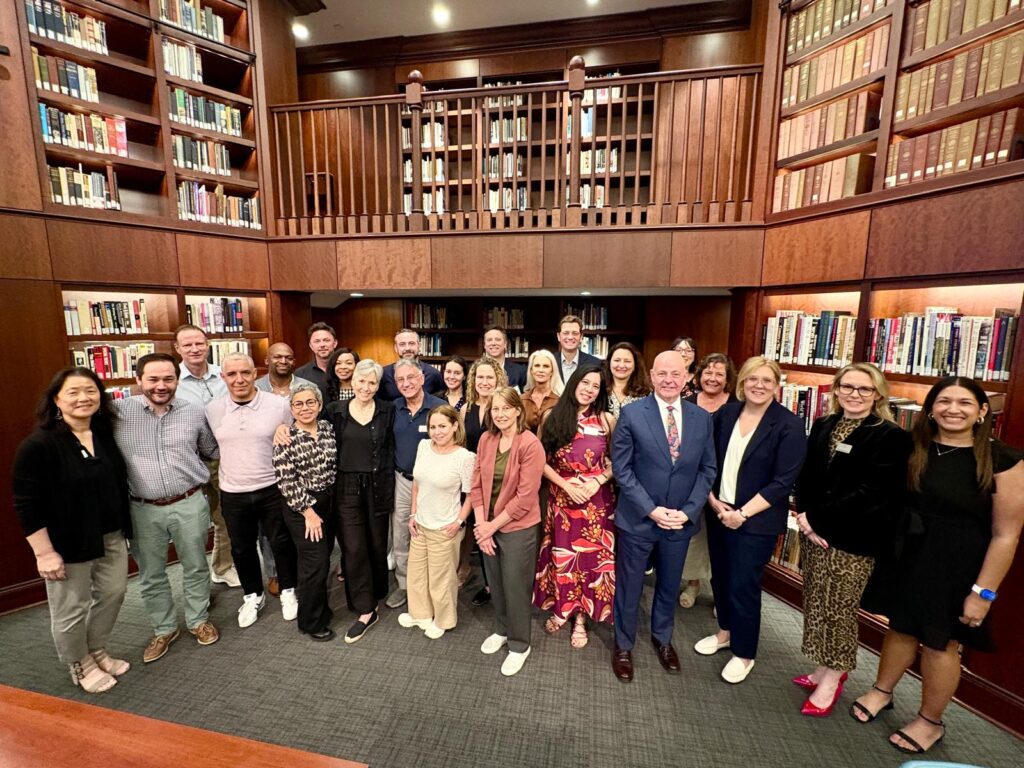By An-Me Chung (2015), Kevin Causey (2016)
Presidential Leadership Scholars (PLS) alumni from across seven different cohorts gathered in April in New Orleans to celebrate 10 years of the program. Set in the inspiring Hall of Democracy at the National WWII Museum, the reunion did what PLSers do best – build community, deepen fellowship, and enable the exchange of ideas with purpose and respect.
Ramsey Green (2015) was the consummate hometown host. Danielle Del Sol, Executive Director of the Preservation Resource Center of New Orleans, thoughtfully shared the history, people, architecture, and culture that embodies New Orleans. An-Me Chung (2015) and Kevin Causey (2016) facilitated a workshop in which they shared tools and strategies to help their fellow alumni – who often have diverse ideologies – engage in meaningful, solution-driven dialogue. In preparation for these challenging conversations, Dr. Mike Hemphill, Co-Director of PLS, joined virtually and reminded alumni that “It never is what it is. It always is what we make it.”
PLSers have long been committed to engage across differences – to listen, learn, and lead alongside those with divergent viewpoints. Within the program’s modules and alumni gatherings, we convene with eagerness, debate with conviction, and support each other’s work in the world. But in today’s polarized climate, it’s not enough to simply be willing to have hard conversations. Now more than ever, we must move into action – engaging in the difficult dialogues that lead to collaborative problem-solving.
Who are we helping, and what problem are we solving?
To lay the groundwork for the group, Kevin reflected on his close personal relationship with fellow PLSer Col. Tim Karcher (2016) as he asserted that deep and meaningful engagement works best when it’s authentic and moves the dialogue forward in a directed manner. Despite coming from different political backgrounds – Kevin is a center-leaning Democrat from California and Tim is a conservative Republican from Texas – the bond that they forged during their cohort experience has remained strong and collaborative.
The key to their productive friendship lies in their ability to move beyond debates over morals, ethics, and values to instead focus on identifying and solving root problems, Kevin said. For example, when he and Tim discussed immigration, they worked to uncover a common understanding of the core issue.
In their conversation about California, they realized they were both concerned about the stability of the state’s agricultural labor force, not immigration itself. Since California supplies 40% of the nation’s food and agriculture is central to both the state and national economies, their fundamental concern was how to ensure a reliable and skilled workforce for agriculture.
Separately, An-Me brought her practical experience of design thinking to the workshop. This is a human-centered approach for problem solving that emphasizes understanding needs and iterative development to create solutions.
To help others apply this kind of problem-solving lens, An-Me divided the alumni into five self-selected working groups focused on education, health care, the environment, the relationship between business and government, and immigration. Before jumping into solutions, each group was asked to take two foundational steps:
- Create a persona: Each team developed a biographical sketch of a real person whose life is directly impacted by the issue at hand.
- Define the root problem: Teams then worked to distill the broad issue into a specific, clearly articulated problem that affected their persona.
For example, one group exploring the intersection of business and government created the persona of Carlos, a 32-year-old married father of two who lays cable for an internet provider. Rather than framing the issue around the abstract concept of a shifting workforce in a tech economy, the group focused on Carlos’s imminent reality: his division was being downsized as data delivery shifted to the cloud. The group centered their problem around how Carlos could prepare for this change and secure his family’s future.

Solutions to complex problems are hard but possible
Throughout the process, teams grappled with hard questions and even harder conversations. Some dialogues grew tense, as participants wrestled with uncomfortable truths. But progress came when they pushed past surface-level disagreements and engaged with the root problem in a meaningful way.
The final exercise brought the work home – literally. Each participant was asked to state, aloud, how they would apply what they learned to real problems in their communities. This act of self-accountability reinforced a central truth: Solving complex problems requires collaboration with people who may strongly disagree with you. It demands compromise, discomfort, and deep, often difficult dialogue – with others and with oneself.
And that’s the real work. Even – and especially – for PLSers.

